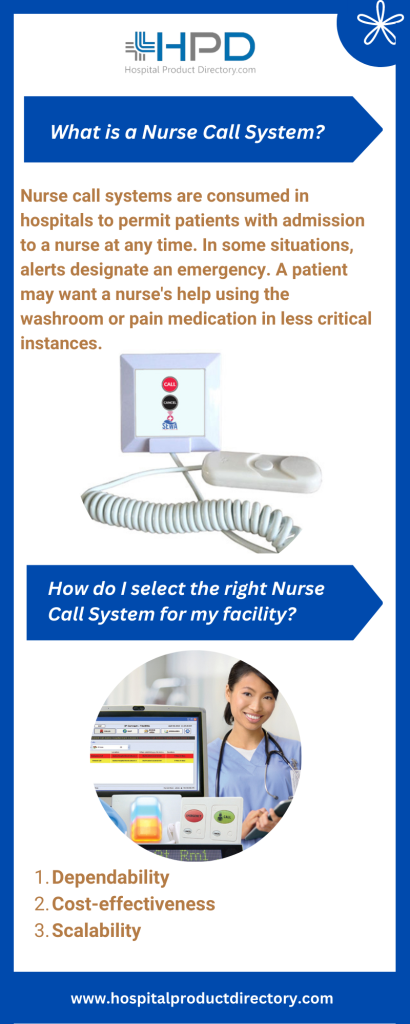If you are a hospital manager, doctor, or nurse, you recognize the position of having a dependable and well-organized nurse call phone system. This article will discuss the kinds of Nurse Call Systems, what to consider when selecting your new system, and why a hospital must buy an updated nurse call system from Nurse Call System Suppliers.
What is a Nurse Call System?
Nurse call systems are consumed in hospitals to permit patients with admission to a nurse at any time. In some situations, alerts designate an emergency. A patient may want a nurse’s help using the washroom or pain medication in less critical instances.
A nurse call system is an alarm facility that patients or hospital staff trigger by pressing a key on a bedside pendant, wall-mounted box, or remotely from another room using keys positioned near the door of the patient’s room or via a nurse call pendant.
How do I select the right Nurse Call System for my facility?
When buying a new nurse call system, dependability, cost-effectiveness, and scalability are the most significant factors. These must be considered before making any conclusions about which explanation would work best for your nursing staff and facility requirements.
Dependability – A good nurse call system will be highly dependable, permitting your nurses to reply rapidly in an emergency.
Cost-effectiveness – An imperative factor is the price of the overall solution when considering all facets such as connection costs and ongoing upkeep fees.
Scalability – The new nurse call system desires to lodge future growth without having to connect new phone lines or buy added equipment. A nurse call phone system must allow for an infinite number of pendants or positions throughout the nursing floor so that patients have easy admission to get assistance at any time desired.

What characteristics must I look for in a nurse call phone system?
When bearing in mind which qualities must be comprised with your new nurse call system, you must consider the following:
- Number of pendants and keys desired
- Local or distant initiation capabilities (with an
- option to pick either)
- Cordless process, if anticipated
Whether it is intended as part of a more widespread
hospital telephone system or as a distinct network
- How many total users will be opening the facility
- Ability to enlarge to house more users in the future
Why must hospitals update their nurse call system?
IMPROVED NURSE DISPERSAL
It is now imaginable for patients to send warnings to a nurse call position, which will then direct a message to the nurse’s phone. Communications are then marked as “established” once a nurse opens the communication, and they can reply with “receive” or “inaccessible” (or alike terms) to designate whether or not they can directly address the situation. With this progression comes several paybacks, including higher patient gratification, improved communication, better nurse organization, and so much more.
ENHANCED COMMUNIQUÉ BETWEEN CAREGIVERS AND PATIENTS
Modern nurse call systems often comprise an advanced messaging system that mechanically sends nurses and physicians communications based on patient illness, the nature of the call, and whether or not a doctor may be required. Also, these call systems can ease two-way communication straight between patients, nurses, and doctors, based on which nurses are allocated to which beds. Instead of unceasingly talking to a nurse at the station who then communicates the information to the nurse who will tackle the call, patients can speak directly to the nurse who will appear to them once allotted.
Better INFORMATION OBTAINABLE TO NURSES
Nurses replying to a call can get more evidence through a modern nurse call system than they could a decade ago. A text communication or even an audible declaration coming from their phone can notify them of the straight nature of the call, such as “Fall Warning in Room 218”. Even more, information is obtainable when nurse call systems are connected to heart monitors and other medical equipment to notify nurses of acute, dangerous conditions such as patient arrhythmias or hazardously high fevers.
BETTER ORGANIZATION
Updated nurse call systems have several characteristics that can support managing the many nurses and patients in a hospital. A central station can open information based on the nurse’s location within the hospital (regulated through the nurse’s work phone, characteristically), the type of the patient’s call, and other information. This permits it to regulate who would be best suited to answer the call if the prime nurse is not obtainable and the call needs to be intensified. Plus, descriptions and logs on nurse calls can be produced mechanically by the system, which makes for better organization and accountability. These systems can also support the hospital as a whole, as information can be used to apprise other departments, such as when patients leave and cleaning needs to ship-shape up the room for a new patient.
BETTER AND EARLIER REJOINDER TIMES
With all the information, mechanization, and distribution surrounding these new nurse call systems available with Nurse Call System Suppliers, patients get replies to their requirements faster, calls are easier to order, and nurses distinguish more about what they are walking into when they reply to a call. They are talented to be quicker in their care. And, if more personnel are required for a given state, warnings are sent out rapidly to guarantee the right people are there to support.
HIGHER PATIENT GRATIFICATION
When patients are seen rapidly and efficiently, they can be a little more content and a little happier in an otherwise less than enjoyable situation. Treating patients whose requirements are being met more rapidly and efficiently can make the work setting easier for nurses, doctors, and staff, which can lead to less strain and more gratification for these employees.
